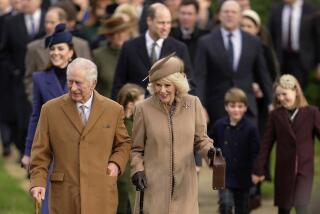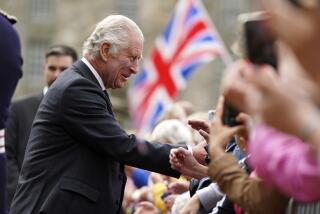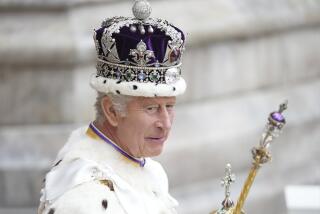Britain’s Charles : Royal Critic: A Power in Architecture
- Share via
LONDON — The mood was festive that memorable night in 1984 as members and guests gathered at the 16th-Century palace of King Henry VIII for an elaborate candlelight dinner marking the 150th anniversary of the Royal Institute of British Architects.
The guest of honor was Prince Charles, and as author Anthony Holden recalls in his biography of the heir to the British throne, “The 700 architects present anticipated a predictable string of princely platitudes and a royal celebration of their 150 years of glorious service to the community.”
‘A Giant Glass Stump’
Instead, “Charles proceeded to tear his hosts limb from limb,” branding them an “arrogant” breed insensitive to community needs and using terms such as “a monstrous carbuncle” and a “giant glass stump” to characterize specific examples of their work.
Optimists among the shaken architects figured that as brutal as the prince’s criticism had been, the flap would quickly blow over. His were the words of a frustrated monarch-in-waiting with too little to occupy his time, and by the time the next polo season rolled around, he would shift his attention elsewhere, they hoped.
Five years later they know better.
Even his harshest critics now say that the self-effacing Charles, who admittedly has no academic credentials in the field, has nevertheless become a dedicated and powerful influence on British architecture. And in the process he is changing perceptions of the Royal Family as well.
Britain’s royals are typically viewed as little more than quaint figureheads at home and good-will ambassadors abroad. Prime Minister Margaret Thatcher’s aides write what is misleadingly called the “Queen’s Speech” outlining the legislative program at the start of each new session of Parliament. And there was a mini-scandal earlier this year when it was reported that Queen Elizabeth had said that she would like to visit Moscow, a politically sensitive trip over which Thatcher is final arbiter.
Leaves Politicians Behind
However, wrote columnist Ferdinand Mount in last Friday’s Daily Telegraph, given Charles’ track record, “a constitutional historian recently arrived from Mars might rub his eyes and wonder whether all the stuff he has read about the impotence of the British monarchy is true. Far from the heir to the throne having to worry about overstepping the political mark, it now seems to be the politicians who have to worry about keeping in step with him.”
“The Prince Finally Declares War,” said a headline in the current issue of the Architects’ Journal reporting the latest forays in what has become a full-fledged and enormously popular royal campaign.
In a new book published last week, “A Vision of Britain,” Charles outlines his “10 principles” of good architecture. And a $300,000 exhibit based on his architectural likes and dislikes opened last Friday at London’s Victoria and Albert Museum.
Determined to translate his words into deeds, the prince is also overseeing construction of a new town on royal estates in southwestern England. He calls it “my own small contribution to the vision of Britain.”
Royalty has had an enormous influence on the arts throughout history, of course, usually through its powers either of patronage or dictate. If a monarch found a work not to his taste, he might just order the artist’s head lopped off--a message guaranteed to impress the unfortunate victim’s peers.
Charles, by contrast, exercises his influence with the 20th-Century tools of the populist politician, exhibiting a veteran campaigner’s instinct for the attention-grabbing one-liner that makes a perfect “sound bite” for the evening television news.
‘A Colossal Fossil’
He has described a new parking structure as “a colossal fossil” and a modernistic municipal building on the Thames as “this excrescence.” London’s changing skyline, he complained, resembles “a jostling scrum of skyscrapers, all competing for attention.”
With his love of classical architecture, and his calls for buildings that “complement our human scale and reflect the character of our heritage,” Charles has tapped a widespread public nostalgia for a gentler, romanticized past that exists hand in hand here with the headlong rush toward Thatcherite prosperity.
It’s the same stirring that fuels this country’s growing environmental movement and that laments the supposed passing of the “traditional” British pub, with its neighborly good cheer, dart board in the corner and Labrador retriever in front of the fireplace.
“In a rapidly changing world, with new technological breakthroughs every other day, what on Earth is wrong with people desiring surroundings which are familiar, traditional, well tried and beautiful?” Charles asks rhetorically in his book. “Such a desire does not mean that we are any the less ‘modern,’ that we are suddenly going to revert to a pre-industrial existence and behave in an 18th-Century fashion. Far from it, it seems to me that such a union of apparent opposites is essential for our sanity in today’s world.”
Not Anti-Everything
Charles says he is not against all modern architecture.
“In newer countries than ours, there was perhaps more point in architects creating dramatic skylines,” he writes. Cities such as Dallas and Pittsburgh “undoubtedly have a powerful presence,” he adds, because “skyscrapers and adventurous forms do not smother and dwarf the past in quite the same way as they do in Britain. . . . How humane they are to work and live in is another question.”
Leading British architects have tried matching Charles epithet for epithet, denouncing his “fogyish obsession” with classical styles and his “Disneyland approach” to ornamentation. His ideas have been mocked as “absurd,” “facile,” “eccentric,” “naive” and even “undemocratic.”
But while they may still resent his tactics and consider his attachment to the past romantic, even the professionals now accept that Charles’ interest in architecture and urban planning are more than the temporary fancy of a coddled 40-year-old with not enough to do.
“One has to say that he is genuinely concerned, more than any member of the Royal Family past or present, with peoples’ lives and the meanings of peoples’ lives,” said William Rodgers, managing director of the Royal Institute of British Architects.
Squelched Projects
The professionals have also learned that they fail at their own risk to take Charles’ architectural opinions seriously. The designs for at least two proposed building projects in central London were unceremoniously scrapped following princely swipes. One was the “monstrous carbuncle”--an addition to the National Gallery, an art museum that dominates the north side of Trafalgar Square.
Now, the most common “question in any discussion about a new building is: ‘What would the Prince of Wales say about it?’ ” commented the Royal Institute’s president, Maxwell Hutchinson, in an interview. Hutchinson has even responded to Charles’ criticisms in his own book--”The Prince of Wales: Right or Wrong?”--due to be published later this month.
Architects also appear to enjoy the unaccustomed public attention that the prince’s campaign has focused on their normally low-profile profession. A poll in the current issue of the Architects’ Journal found that while a majority still disagree with his views, particularly about classical architecture, 78% feel he should continue to speak out.
The danger, warned Rodgers, is that as a result of Charles’ popular attacks on modern designs, architects will be afraid to experiment; that the prince “is influencing people in the direction of being cautious.”
Referring to the prince’s 10 principles, Hutchinson added, “If they suddenly take on a significance, a royal significance in being endorsed by him as some sort of special code by which buildings should be built, I’ll find it very dangerous indeed.”
Charles’ architectural principles are very general. He wants buildings made of local materials that fit into their surrounding landscape and are of a size appropriate both to their function and their locale, for example. He likes plazas and gardens, and he dislikes signs.
But the next major round of the great architectural debate is likely to be much more specific, probably focusing on the new town of Poundbury being planned for up to 10,000 residents on a part of the prince’s Dorset estates.
“I think time alone will make a judgment about his overall influence” on British architecture, said Hutchinson. But five years after he first broached the subject at that gala dinner, at least one thing is already clear for Britain’s architects. As the Daily Mail put it in a headline last week, Charles’ is “The Voice They Can’t Ignore.”
More to Read
The biggest entertainment stories
Get our big stories about Hollywood, film, television, music, arts, culture and more right in your inbox as soon as they publish.
You may occasionally receive promotional content from the Los Angeles Times.










